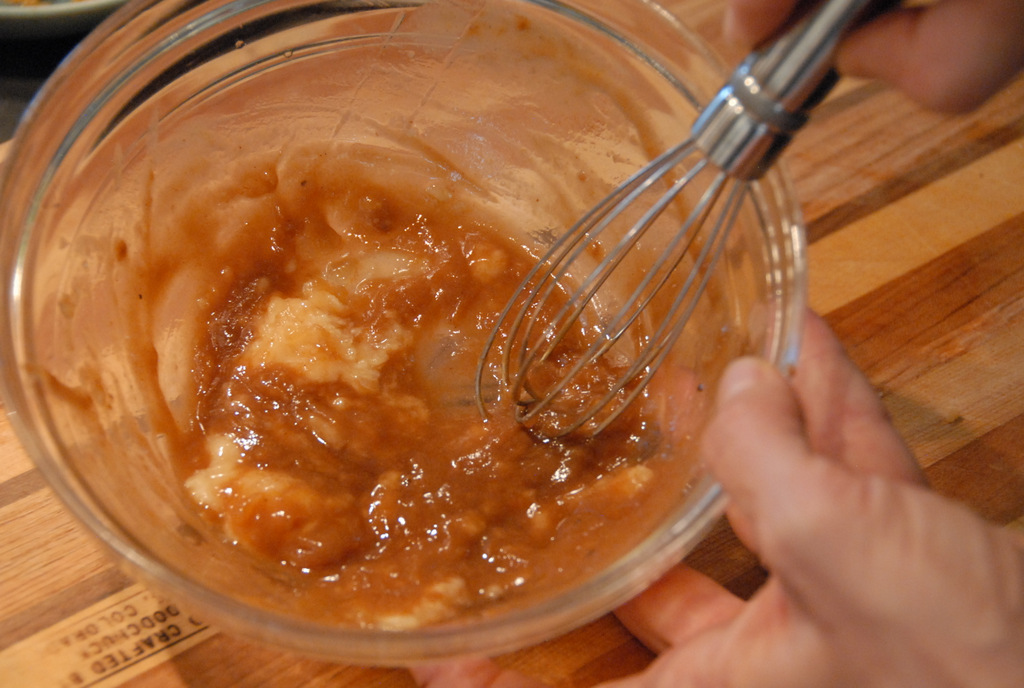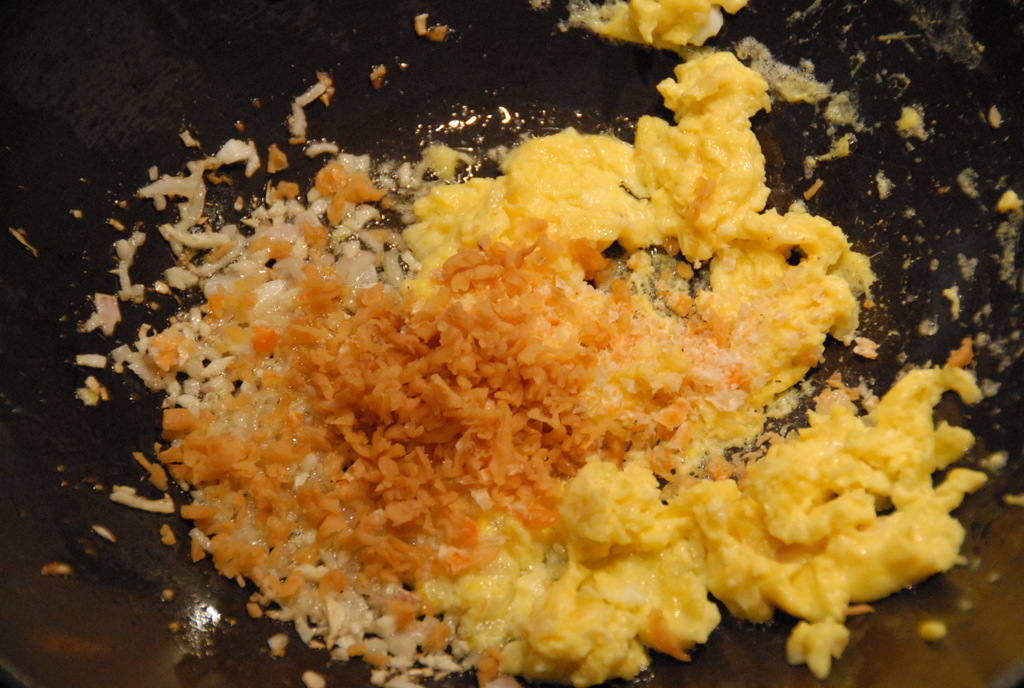Pad Thai w/Kale & Collards Kimchi
I’ve heard that Pad Thai (stir-fried rice noodles Thai-style), the sweet and savory dish many Americans think of as a Thai staple, is not easily found in restaurants in Thailand. It is commonly prepared by street vendors (video), and is apparently rather ubiquitous in touristy areas. Well, I hope some day to be able to find out for myself. In the meantime, I prepare it at home, and can make a pretty good version thanks to Robert Danhi. Robert is a talented American chef who specializes in southeast Asian cooking. His book, ‘Southeast Asian Flavors‘ has won several awards. I feel fortunate to have had the opportunity to watch Robert prepare Pad Thai, and was careful to take lots of notes.
Pad Thai Ingredients:
1/2 lb Dried flat Thai noodles
1/4 Cup Red Boat fish sauce
2 TBS Tamarind pulp
1/4 Cup palm sugar
2-3 Dried roasted chilies, ground
2 TBS vegetable oil
1 TBS shallots, minced
1 TBS garlic, diced
2 Eggs, lightly beaten
1 TBS dried shrimp, chopped
3/4 Cup pressed tofu or chicken or protein, sliced into strips
1 TBS Pickled radish (daikon), chopped
1 Cup scallions (greens only), sliced diagonally
2 Cups mung bean sprouts
1/2 Cup dry roasted peanuts, chopped
Ozuké Kale & Collards Kimchi
Water as needed
 Directions:
Directions:
Instruction #1 – Purchase excellent ingredients
Each ingredient is essential, and most important are those in the special sauce! They create the tasty balance between sweet and sour, and are the foundation of Pad Thai. Where does the sour flavor come from? It comes from the tamarind fruit. I was able to find pure tamarind pulp (nothing added), and “seedless”. When I opened the bag, I found delicious pulp AND a gazillion seeds. Because of those seeds, preparing the tamarind pulp for the recipe took a bit more time than I had thought it would, but it was well worth it!
Where does the sweet come from? It comes from thick, rich palm sugar. Palm sugar is available in different forms. Because the paste dissolves more easily than discs, I prefer the paste.
Instruction #2 – Prepare all your ingredients before cooking
Begin by making tamarind paste for special sauce.  To prepare the paste, break off a piece of the gooey tamarind, and mix with water. Use fingers to massage the pulp, removing seeds and any other plant material. Add more water if needed. Place tamarind pulp through a fine mesh strainer. Using a spoon, push through strainer, and scrape the bottom to collect the tamarind paste.
To prepare the paste, break off a piece of the gooey tamarind, and mix with water. Use fingers to massage the pulp, removing seeds and any other plant material. Add more water if needed. Place tamarind pulp through a fine mesh strainer. Using a spoon, push through strainer, and scrape the bottom to collect the tamarind paste.
 Add the palm sugar to the prepared tamarind paste, blend thoroughly. Then add fish sauce and chili flakes, whisk. Set sauce aside, and prepare other ingredients for deliciousness!
Add the palm sugar to the prepared tamarind paste, blend thoroughly. Then add fish sauce and chili flakes, whisk. Set sauce aside, and prepare other ingredients for deliciousness! 
 Noodles next – soak noodles in room temp water for 25 minutes. Drain noodles, and set aside.
Noodles next – soak noodles in room temp water for 25 minutes. Drain noodles, and set aside.  While noodles are soaking prepare other ingredients – pan roasted peanuts (chopped), lightly roasted Thai chilies (ground), scallions (sliced), radish (chopped), shrimp (chopped), tofu (sliced), eggs (lightly beaten). Set up your cooking station – mise en place.
While noodles are soaking prepare other ingredients – pan roasted peanuts (chopped), lightly roasted Thai chilies (ground), scallions (sliced), radish (chopped), shrimp (chopped), tofu (sliced), eggs (lightly beaten). Set up your cooking station – mise en place.  Instruction #3 – Cook Pad Thai
Instruction #3 – Cook Pad Thai
Heat pan on medium-high, once hot, add oil & garlic. Cook until edges are lightly brown. Push garlic to side of pan, add beaten eggs, and scramble. Keep garlic off to side. Add tofu, shrimp and radish. Mix it all together. 
 Once mixed, add noodles, 2/3 of the special sauce, and some water. Toss well.
Once mixed, add noodles, 2/3 of the special sauce, and some water. Toss well. 
 Continue tossing until noodles are soft, but not mushy. Add water (for cooking) and more sauce (for flavor) as needed. Be sure to add water in small amounts to prevent noodles from getting soggy. Continue tossing. Once noodles are cooked, chewy NOT soggy, add most of the scallions, peanuts, and bean sprouts, reserving some for garnish. Mix well.
Continue tossing until noodles are soft, but not mushy. Add water (for cooking) and more sauce (for flavor) as needed. Be sure to add water in small amounts to prevent noodles from getting soggy. Continue tossing. Once noodles are cooked, chewy NOT soggy, add most of the scallions, peanuts, and bean sprouts, reserving some for garnish. Mix well.  Instruction #4 – Eat
Instruction #4 – Eat
Serve and garnish with more peanuts, bean sprouts, scallions, and Ozuké Kale & Collards Kimchi – Voilậ! Pad Thai that is great tasting and good for your gut, too! And perhaps the best part, you too can watch Robert prepare this recipe in his Thai Cooking Essentials class available at Craftsy.com.

